Much of the Israeli-Palestinian conflict is about land. There are strong Christian, Muslim and indeed Jewish ties to the region. But there’s one particular parcel of land that is fraught with history, symbolism and meaning, not just to the Jews and Palestinians living in Israel, but to people around the world.
The Temple Mount.
This trapezoid-shaped esplanade is the most sensitive 37 acres in Israel, maybe even in the world. Most prominent is the iconic glittering golden-roofed Dome of the Rock. Inside is the Foundation Stone, which many believe is the location of the Holy of Holies. Sitting on the southern edge of the plaza is the Al-Aqsa Mosque. At the bottom of the western side of a retaining wall surrounding the Temple Mount is the Western Wall.
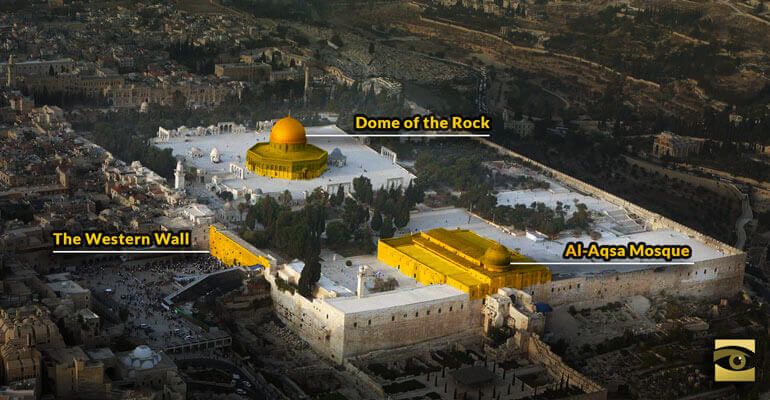
On any given day, pilgrims from all over the world come to Jerusalem looking for God, or at least some kind of spiritual experience. Within walking distance of the Temple Mount are Mount Zion, the Mount of Olives, the Church of the Holy Sepulchre, the Via Dolorosa, Siloam’s Pool and Hezekiah’s tunnel and other sites associated with the Bible.
With so many holy and historical sites, why is the Temple Mount the one place that arouses so much more passion?
 Jewish ties to the Temple Mount run deep. In Jewish tradition, the Temple Mount is considered the holiest spot in the world, the site of the First and Second Temples built by King Solomon and Zerubbabel respectively. Ground zero would be the Holy of Holies, the Temple’s inner sanctum which the High Priest only entered once a year.
Jewish ties to the Temple Mount run deep. In Jewish tradition, the Temple Mount is considered the holiest spot in the world, the site of the First and Second Temples built by King Solomon and Zerubbabel respectively. Ground zero would be the Holy of Holies, the Temple’s inner sanctum which the High Priest only entered once a year.
Known in Hebrew as Har HaBayit (Temple Mount) or Har HaMoriah (Mount Moriah), the Temple Mount’s holiness is so transcendent that many observant Jews will not go there while in a state of ritual impurity (more on that below). This restriction on visiting complicates efforts to strengthen Jewish ties to the Temple Mount. The closest spot to the Temple where the vast majority of Jews pray is the Western Wall, a retaining wall around the Temple Mount.
The Foundation Stone (Even ha-Shtiyya in Hebrew), which is inside the Dome of the Rock, is assumed by many to be the spot where the Ark of the Covenant sat inside the Holy of Holies, the first place where earth appeared on the third day of creation, and the spot where Abraham prepared his son Isaac as a sacrifice.
According to Jewish tradition, the Third and final Temple will be built there too.
Related reading: Religious Freedom in Israel
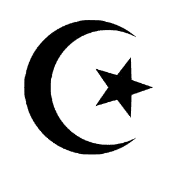 For Muslims, the Temple Mount is known as Haram al-Sharif (the Noble Sanctuary). The Al Aqsa Mosque is Islam’s third holiest site.
For Muslims, the Temple Mount is known as Haram al-Sharif (the Noble Sanctuary). The Al Aqsa Mosque is Islam’s third holiest site.
Much of the Temple Mount’s prominence stems from the story of the prophet Mohammed’s Night Journey. According to Islam, Mohammed flew from Mecca to Jerusalem on a winged horse which landed atop the Western Wall. At the site of the Al-Aqsa Mosque, Mohammed led prophets in prayer. From the Foundation Stone, he ascended to heaven and met with other prophets before returning to Mecca.
The Dome of the Rock is among the oldest works of Islamic architecture extant and its glittering gold dome is the most iconic image associated with Jerusalem today. In Arabic, the Western Wall is called the Wall of Buraq (Hait al-Buraq) after the horse.
 For Christians, the Temple is where Jesus was found at a young age debating law with the rabbinic elders (the Finding in the Temple), and where he later expelled the money changers and merchants (the Cleansing of the Temple).
For Christians, the Temple is where Jesus was found at a young age debating law with the rabbinic elders (the Finding in the Temple), and where he later expelled the money changers and merchants (the Cleansing of the Temple).
Christianity’s historical Jewish roots make the Temple Mount a very popular pilgrimage site. Although they don’t have a formal role in administering the holy site, church leaders follow developments on the Temple Mount and often speak out on issues regarding its status quo. The remains of a Byzantine era mosaic found under the Al-Aqsa Mosque — the only archeological excavation ever undertaken there — are thought to be the remains of a church or monastery.
The purpose of this article is not prove or disprove any side’s claim, but to simply better understand Jewish ties to the Temple Mount.
Join the fight for Israel’s fair coverage in the news
The status quo
The existing state of affairs currently governing the Temple Mount goes back to 1967, when Israel captured eastern Jerusalem from Jordan. Days after the war, defense minister Moshe Dayan met with Jerusalem’s Muslim leaders. Fearing a wider religious war, Dayan agreed to let the Jordanian-run Islamic Waqf continue administering the Temple Mount.
(A waqf is a trusteeship. The waqf overseeing the Temple Mount today is also responsible for other Muslim institutions in Jerusalem, including schools, mosques, religious courts, orphanages, libraries, museums, and other properties.)
The informal status quo coming out of that meeting was as follows:
- Jews and non-Muslims would be allowed to visit the Temple Mount.
- Jews and non-Muslims visiting the Temple Mount would respect Muslim religious feelings.
- Jews and non-Muslims would not be allowed to pray on the Temple Mount.
- The Western Wall would be the primary place of Jewish prayer.
- The Islamic Waqf would oversee daily administration of the Temple Mount while Israel would retain “overall sovereignty.”
After the war, the Knesset passed the Preservation of the Holy Places Law, ensuring freedom of access and protection to holy sites under Israeli jurisdiction, including eastern Jerusalem.
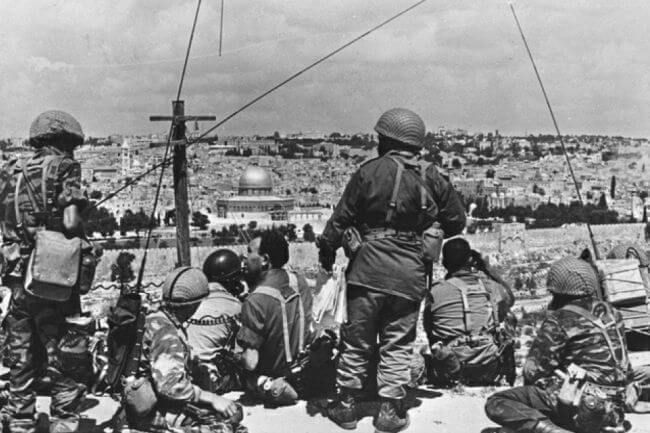
The Israeli courts have rebuffed challenges to the ban on Jewish prayer. In a 1976 ruling on a case in which the police expelled a Jew from the Temple Mount for praying, Supreme Court president Aharon Barak wrote:
The basic principle is that every Jew has the right to enter the Temple Mount, to pray there, and to have communion with his maker. This is part of the religious freedom of worship, it is part of the freedom of expression. However, as with every human right, it is not absolute, but a relative right… Indeed, in a case where there is near certainty that injury may be caused to the public interest if a person’s rights of religious worship and freedom of expression would be realized, it is possible to limit the rights of the person in order to uphold the public interest.
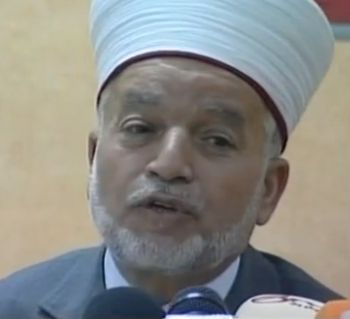
The Israel-Jordanian peace agreement of 1994 (article 9) enshrined a “special role” for the Jordanian monarchy in the administration of Jerusalem’s Muslim holy sites, including the Temple Mount. However, in a separate deal with the Palestine Liberation Organization in 1994, Jordan transferred the role of Grand Mufti — the leading religious figure –to the Palestinian leadership. The current Grand Mufti, appointed by Mahmoud Abbas and receiving a PA salary, is Mohammed Hussein, who rejects Jewish ties to the Temple Mount — specifically denying that the Temple ever existed there.
More recently, in February, 2019, Jordan expanded the size of the Waqf council to add more Palestinians. This enlarged council includes former mufti Sheikh Ekrima Sabri, who is close to Ankara and helping expand Turkish influence in Jerusalem.
Related reading: How Ancient Coins and Seals Prove the Jewish Connection to Jerusalem
The current Waqf’s denial of the existence of the two Jewish Temples is inconsistent with the Waqf’s teachings in the past. The Official 1925 Supreme Moslem Council (Waqf) Guide Book to the Temple Mount, refers to the Temple of Solomon and quotes King David’s role from Samuel II 24:25:
The site is one of the oldest in the world. Its sanctity dates from the earliest (perhaps prehistoric) times. Its identity with the site of Solomon’s Temple is beyond dispute. This too is the spot, according to universal belief, on which “David built there an altar unto the Lord and offered burnt offerings and peace offerings.”
The guidebook also describes Solomon’s Stables by quoting Josephus:
Little is known for certain of the early history of the chamber itself. It dates probably as far back as the construction of Solomon’s Temple. According to Josephus, it was in existence and it was used as a place of refuge by the Jews at the time of the conquest of Jerusalem by Titus in the year 70 A.D.
Related reading: Stories I’d Like to See: Background on the Temple Mount Troubles
The Temple Mount’s history
Creation: In Jewish tradition, the Temple Mount was the first land to appear when land and water were separated on the third day of creation.
c. 2000 BCE Abraham prepares Isaac as a sacrifice (Binding of Isaac) (Genesis, ch. 22).
c. 1000 BCE King David purchases the threshing floor from Arunah the Jebusite (Samuel II, ch. 24 and Chronicles I, ch. 21). The purchase marks the beginning of formal Jewish ties to the Temple Mount.
825 BCE: Solomon builds the First Temple.
423 BCE: Babylonian King Nebuchadnezzar destroys the First Temple.
353 BCE: Jews rebuild Second Temple.
164 BCE: Hasmoneans revolt against Greeks, purifying and rededicating the Temple in events commemorated by the Chanuka holiday.
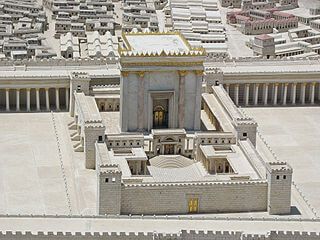
20 BCE: King Herod begins refurbishing the Temple, expanding the Temple Mount and building a retaining wall around it. (The Western Wall is the only remaining part of this retaining wall.)
70 CE: Romans destroy Second Temple, building on top of it a temple to Jupiter Capitolinus.
335 CE: Byzantines consecrate the Church of the Holy Sepulchre. They viewed the Temple’s destruction as a fulfillment of Christian victory over the Jews. As Christian worship shifts to the Holy Sepulchre, the Temple Mount becomes a garbage dump.
638 CE: Umayyad Muslims conquer Jerusalem and begin cleaning up the Temple Mount.
692 CE: The Umayyads complete the construction of Dome of the Rock.
705 CE: The Umayyads build the Al-Aqsa Mosque on the site of a small Muslim prayer house at the edge of the Temple Mount.
1099: Christian crusaders led by Godfrey of Bouillon capture Jerusalem. They convert the Dome of the Rock into a church and Al Aqsa into a Templar headquarters.
1187: The Ayyubids, led by Saladin, take Jerusalem from the Christians and refurbish the Dome of the Rock and Al-Aqsa.
1517: The Ottomans conquer the holy land.
1917: British forces defeat the Turks in World War I. Palestinians appointed by Britain to the Supreme Muslim Council are given responsibility for administering the Temple Mount.
1948: The Israeli War of Independence. Jordan seizes eastern Jerusalem, including the Temple Mount. The Jordanian-run Islamic Waqf is given responsibility for overseeing the Temple Mount.
1967: Israel captures the Temple Mount in the Six Day War.
1996: In violation of the status quo, the Islamic Waqf begins converting an underground passage into a massive prayer hall called the Marwani mosque. Thousands of tons of dirt and rubble containing remnants of antiquities from the Temple period are dumped without archaeological supervision. The Waqf dismisses charges it is systematically destroying Jewish ties to the Temple Mount.
2017: Two Israeli police officers are killed by a terrorist who smuggled a gun onto the Temple Mount. Palestinians riot when Israel installs metal detectors, which are later removed.
Jewish ties to the Temple Mount in tradition
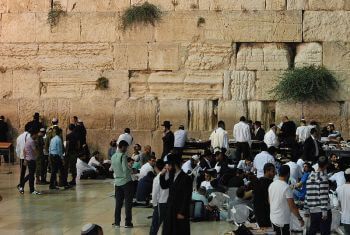
Jewish ties to the Temple Mount have been kept alive over the centuries through a number of Jewish practices, including:
- Around the world, Jews pray facing Jerusalem.
- In Jerusalem, Jews pray facing the Temple Mount.
- In theory, Jews praying on the Temple Mount would face the Holy of Holies.
- Jewish prayers three times a day include a plea for the Temple’s restoration.
- A Jew seeing the ruins of the Temple is supposed to tear his clothing and say “Our house of holiness and glory in which our ancestors sang praise to You, and all that we hold precious has been destroyed.”
- Jews fast and mourn the destruction of the Temples which both fell on Tisha B’Av.
- The Passover seder and Yom Kippur prayers both end with the words, “Next year in rebuilt Jerusalem,” which refers to the Temple.
- At Jewish weddings, the groom breaks a glass and quotes part of Psalm 137 about not forgetting Jerusalem and “may my tongue cleave to the roof of my mouth if I do not set Jerusalem above my highest joy.”
- As an additional sign of mourning, Jewish ties to the Temple Mount are underscored by many observant Jews leaving a small portion of their home unplastered and unpainted.
Despite the long-standing Jewish ties to the Temple Mount, many rabbinical authorities forbid Jews from entering the compound because laws of ritual purity still apply to specific areas. The precise location of the Temple’s inner courtyards and the Holy of Holies are not certain because of different ways to understand the Temple Mount’s measurements described by the Talmud, and because the Temple Mount is significantly larger than it was when the Talmud was codified.
In recent years, some rabbinic opinions have argued that Jews may ascend and visit the areas of the plaza that are certainly not where the inner courtyards or Holy of Holies were because the laws of ritual purity do not apply to the entire Temple Mount. Some rabbis even encourage Jews to visit the hilltop plaza to actively maintain Jewish ties to the Temple Mount.
The details of these rulings and the issues they raise are beyond the scope of this article.
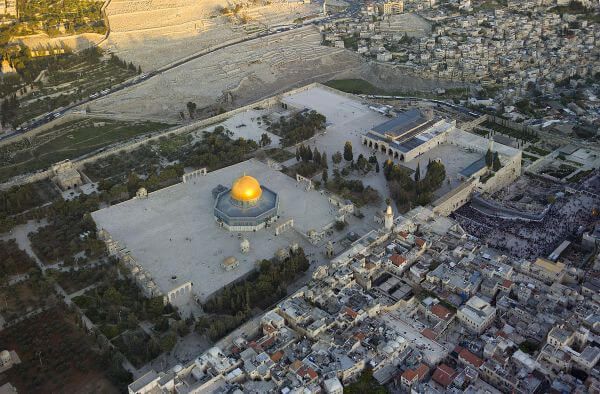
* * *
Spurning Jewish ties to the Temple Mount helps the Palestinians undermine Jewish claims on Jerusalem and negate the very concept of Israel as a Jewish national homeland. That’s why Palestinians value organizations such as the UN Educational, Scientific and Cultural Organization (UNESCO) passing resolutions insisting that Israel has no legal or historical claims on Jerusalem.
Because the Temple Mount goes to the very heart of core Jewish, Muslim and Christian narratives, it poses the greatest sticking point to future Israeli-Palestinian arrangements.
Featured image: CC0 Pixabay; star, crescent and cross via Wikimedia Commons; Mufti via YouTube/AP Archive; Second Temple via Wikimedia Commons; Tisha B’Av via Wikimedia Commons; aerial view via Wikimedia Commons;

